The crazy cars built to sell Thermoses and vacuum cleaners
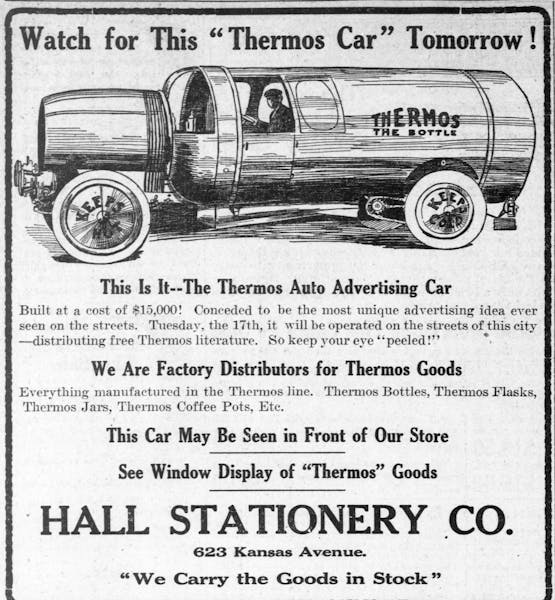
If you search for the term “vacuum car,” Google will likely think you’re looking for the big commercial vacuum cleaners at your local car wash. Perhaps it will try to sell you a 12V portable vacuum to plug into the cigarette-lighter tap in your car. If you’re a car enthusiast, you might associate the phrase with race cars that use fans to suck them to the track, like the Chaparral 2J “fan car” or Gordon Murray’s Brabham T46 or the modern T.50 supercar.
While any of those vehicles are worthy of discussion on an automotive site like this one, for the present we’re going to discuss a different sort of vacuum car: in this case, promotional vehicles. You could say that each one has something to do with nothing, that void being negative atmospheric pressure, aka vacuum.

If you know the Weinermobile, or the Red Bull Mini, you might think that a custom car is a relatively new way to promote a product or business, but “marketingmobiles” have been around for a while, likely ever since the first business that bought an automobile or truck and painted its name on the side. Soon after there were things like the Shoemobile, which promoted the Peters Brothers’ shoe store in San Francisco.

The idea caught on pretty quickly and by the 1920s there were four-wheeled contraptions like mobile coffee pots traveling the roads of Europe and North America. They would gather where the biggest audiences were, often at sporting events, like the Tour de France, which drew millions of onlookers. To take advantage of that publicity opportunity, in 1929, the Tour’s race director and the marketing director of the Menier chocolate company organized a fleet of promotional vehicles that preceded the racers along each stage, a tradition that continues to this day.
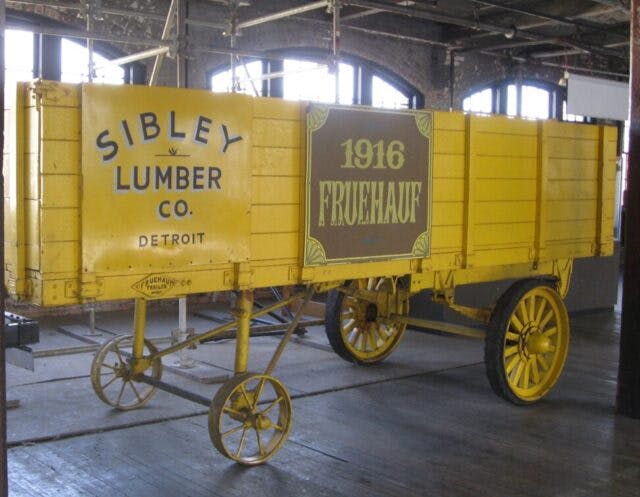
It’s said that when famed recording executive Leonard Chess first heard the blues, he discovered more than a musical genre; he discovered a market, and the same principle applies to promotional vehicles: For every inventor with a clever idea, there’s probably at least one business person who can take that idea farther than the inventor could have dreamed. You and I would probably never have heard of Soichiro Honda were it not for his business partner, Takeo Fujisawa, who convinced Honda that making the Super Cub—which would become the best-selling motor vehicle in history—was a better idea than going racing on the Isle of Man. And we might not have the promotional vehicles we have today if it weren’t for two rather inventive entrepreneurs.
We’ll start with a brand that, over 100 years after its first promotional vehicle, remains a household name: Thermos.
In the early automotive era, the Vanderbilt Cup Races, held from 1904 to 1910, were a big deal. Then, as now, the elite believed that European automakers made machinery that was superior to that of American companies. To encourage U.S. makers of automobiles to compete with continental firms, William K. Vanderbilt Jr., a pioneering racer and heir to a railroad fortune, sponsored the first international road race to be held in America. Among the most popular sporting events of the time, the races were held on New York’s Long Island, and as many as a quarter of a million spectators attended.

In 1909, along with those thousands of spectators, was a Thermos — The Bottle truck. Mounted on a chain-driven, six-cylinder Napier truck chassis, the body was said to be an exact scale replica of the original Thermos Bottle. Made of cast aluminum mounted to a wooden frame, the body is reported to have weighed more than 2 1/2 tons. The hood of the truck was cleverly shaped like the Thermos Bottle’s screw-on cap/cup, complete with threads. The front wheel covers read “Keeps Hot” while the rear hubcaps said “Keeps Cold.”
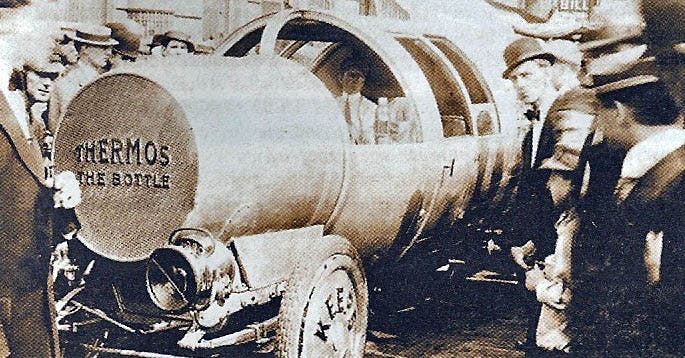
The story of the product itself began almost twenty years earlier, in 1892, when Scottish scientist Sir James Dewar invented the vacuum flask. To keep chemicals at stable temperatures, he placed one glass bottle inside another, evacuated the air between them, and created a very effective insulated container. His discovery led to the manufacture of what is known as the Dewar Flask in 1898. Five years later, Dewar’s glass blower, Reinhold Burger, along with Burger’s business partner, Albert Aschenbrenner, patented the idea of reinforcing and protecting the outer bottle with a steel skin. They named it Thermos after the Greek word for heat, because it could keep hot liquids, like coffee or soup, hot for hours.
While traveling to Berlin, American businessman William B. Walker met Burger and struck a deal to import Thermos bottles and secure the rights to manufacture them in the United States. In 1907, Walker founded The American Thermos Bottle Company. He leased a factory in Brooklyn, New York, imported machinery from Germany, and began training workers under the supervision of Burger and German glass blowers.
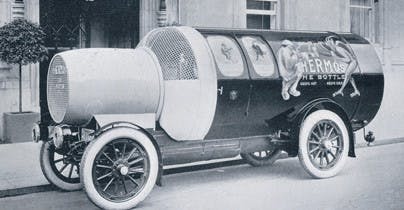
It made perfect sense for Walker to promote the new Thermos Bottle at the Vanderbilt Races, since so many were in attendance, and more than a few of the spectators were among the most affluent Americans. The Thermos Bottle truck appeared at other automotive events like the 1909 Automobile Carnival Parade, held in New York City, along with other promotional vehicles that the New York Times described as “grotesque.” The Thermos truck was even part of a World War I victory parade, though the body of the vehicle shown in a photo of the event has differently shaped windows than the original one.
The Thermos company even put the Thermos Bottle truck on tour. Walker must have liked the idea because Thermos made replica trucks at least into the 1920s, based on Ford Model TT trucks. The fate of the Napier-based 1909 Thermos truck is not known, but at least one of the Ford-based vehicles still exists and it has been restored by Larry Canova of Norwich, Connecticut. Canova has a sentimental attachment to the Thermos brand since his grandfather worked for the company driving trucks, though it isn’t clear if he drove the actual Thermos-shaped trucks.
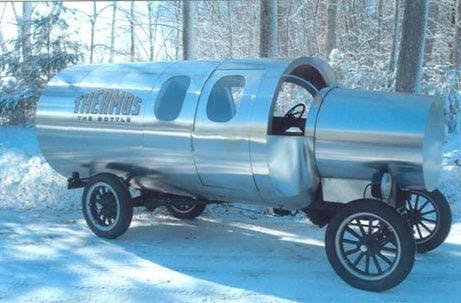
Now, for our second entrepreneur. Axel Wenner-Gren was not an inventor, but he had an inventive mind that could see the possibilities of others’ inventions. Born in 1881 in Sweden to a family made wealthy by exporting lumber, he spent five years working for his uncle’s spice-importing company in Gothenburg. In those hours after school, he picked up English, French, and German and then moved to Germany, where he enrolled in business school, from which he graduated early. Afterwards, he worked as a salesman for the German subsidiary of Alfa Laval Separator, and then with backing from his father he opened up a business near Stuttgart selling agricultural machinery.
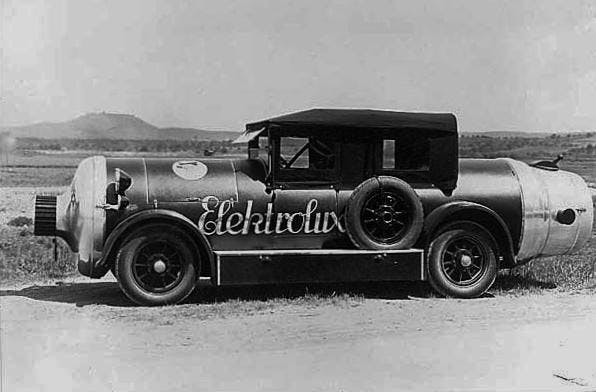
From his exposure to separation equipment, Wenner-Gren was familiar with processes that used vacuum. When he saw a home vacuum cleaner made by Santo in the Viennese shop of Gustaf Paalen, he realized that the machine had enormous potential as a consumer product. Failing to make a distribution deal himself with Santo, he purchased 20 percent of Paalen’s company, which had exclusive rights to sell the cleaner in Europe.

Wenner-Gren continued to work as a salesman and by the end of World War I, he held controlling interest in a company called Svenska Electron that was apparently representing a Swedish lighting company named Lux. (In one version of the story, Wenner-Gren successfully convinced Lux to buy a patent for a home vacuum cleaner, agreeing that in lieu of cash, he would get stock in Lux based on how well the vacuum cleaners sold, eventually owning enough stock that he controlled the company.)
Also, Wenner-Gren is supposed to have suggested the name change to Electrolux. According to official Electrolux history, though, it was in 1919 that a licensing agreement between Elektron and Lux gave Elektron the sole rights to sell Lux vacuum cleaners, and a month later Elektromekaniska AB, a wholly owned subsidiary of Elektron, officially changed its name to AB Electrolux.
However it happened, by the 1930s Wenner-Gren was one of the wealthiest men in the world. While his name isn’t familiar to us today, his efforts to obtain the vacuum-cleaner contract for the Vatican may have spawned the Hollywood trope of door-to-door salesmen who demonstrated vacuum cleaners.

Supplying the Holy See with vacuums would not only be a valuable contract, it would undoubtedly be a promotional coup for any appliance maker. Five companies each made a pitch, and each were given a piece of soiled carpeting to clean using their respective machines. Wenner-Gren waited until the other four were done with their demonstrations, and then went over their pieces of carpet with an Electrolux vacuum cleaner. When he opened the dustbag, showing how his machine picked up dirt the other cleaners left behind, the contract was his.
Sources say that Electrolux was one of the first consumer product companies to use advertising slogans, and Wenner-Gren was always looking for new ways to promote Electrolux. The appliance industry was not the only new, burgeoning industry making its mark on the world. Automobiles and trucks were starting to fill the streets of cities across the world. Using the latter to sell and promote the former was a natural idea.

The original Electrolux vacuum cleaners were barrel-shaped and hard to lug around the house, but in 1921 the company brought out its now familiar and portable, torpedo-shaped, cylindrical “canister” Model V vacuum cleaners. As with the Lifesavers candies and Thermos bottles, the product packaging translated perfectly to a larger scale.
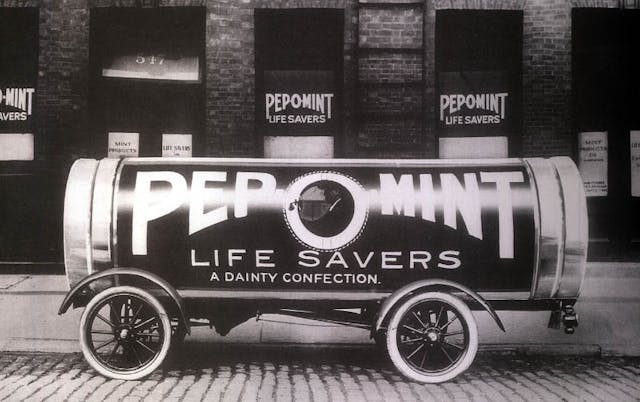
Wenner-Gren commissioned a body shaped like an Electrolux vacuum cleaner to be mounted on an automobile chassis. The reaction was so positive that the company commissioned an entire fleet of Citroën-based Electrolux cars and BSA motorcycles with Electrolux-shaped sidecars to promote the brand in Stockholm, Berlin, and London.

Electrolux contracted with coachbuilders Karosseriwerke Drauz in Heilbronn, Germany, and another firm in Denmark to do the fabrication. In a historical photo taken in Heilbronn, you can see the original Electrolux car, a two-seater, in the background. In the foreground the sleeker, dual-cowl fleet models are being completed.
In 1927, Electrolux organized an incentive “race” in connection with a large sales conference scheduled in Berlin. Teams of four salesmen plus a driver took ten-day routes to the German capital, competing to sell the most vacuum cleaners on the way. When they arrived in Berlin, the vacuum cars were parked outside the Berlin Palace exposition hall, in formation to spell out the word Lux.
There is no record of any of the Electrolux vacuum cars still surviving. If you have a lead, drop us a note in the comments.
***
Check out the Hagerty Media homepage so you don’t miss a single story, or better yet, bookmark it. To get our best stories delivered right to your inbox, subscribe to our newsletters.


There was a great tire car in San Fran at that time too. Programmatic architecture was way cool too, something I think it would be cool to see some return of
Being a big fan of the green Stanley Thermos bottles (I have three, one of which has traveled with me on many wonderful adventures and is nearing 60 years old) and also having owned an Electrolux canister in the ’70s, I am flabbergasted that id never heard of either of those vehicles. I’m better educated today than I was yesterday – thanks!
I love seeing these old promo vehicles. I wish there was a good book on these.
In some ways this story ‘sucks’ lol! Love the promo cars! Am thinking of a particular Looney Tunes where Daffy Duck is the door to door salesman selling Elmer ‘The house of tomorrow’. Classic. I’ve been in engineering sales for 40 years and us and the vac guys aren’t that different..
Now that IS a good cartoon. Just don’t push the red button!
The “vac guys” got to me when I built my house in 1995. One day when Mrs. DUB6 was at work and I was home, the doorbell rang. I ended up trading my old Compact egg-shaded vac for a spankin’ new Kirby G-5. Man, was I HOSED when she got home! But she got over it and the Kirby has served well for almost 30 years. Don’t know what this has to do with cars, except I use the vacuum to clean ours out occasionally. But any post with a Daffy Duck reference deserves a response in my book (one of my three Life Heroes). Happy New Year, Mike – and everyone else!
“This Is A Life?” and the Wishy-Washy Washing Machine Company of Walla Walla, Washington. 1955.
I always thought that the AMC Pacer would have made a great vacuum cleaner promo car. Just mount a vertical handle and bag on the rear … especially appropriate since so many folks thought its styling “really sucked.”
I think of the Zippo Lighter car, based on a ‘47? Chrysler, often seen at the Watkins Glen vintage races, and (as a former employee) the L.L. Bean Bootmobile, coming soon to a store near you!
Two others – The giant Spam can, probably built on a motor-home chassis, serving hot Spam samples. The winding key opener was the antenna. The other was the can-shaped V8 roadster, complete with vegetable-shaped appliques on the upholstery. I remember seeing signs at Mosport “See The V8 Roadster” and I wondered why they didn’t say what V8. Finally the penny dropped when I found it.
Nothing sucks like Electrolux!
My parents bought a post war Electrolux Model Z28 in the ’40s – Alligator skin design on the body with no wheels, just the skids. Used for decades, even painted my brother’s Mini in the driveway with it. Still working when I tossed it cleaning out my dad’s house last year. They were tough.
Why did you toss it? That is sad. Surely some collector would have wanted it.
Should not make Thermos, a brand name, plural. Must use a generic with a trademark name.
??????????????
You missed the “Zippo” lighter 1950s Caddy at Watkins Glen N.Y.
As a 25 year engineering employee of the Fruehauf Corp., I’m familiar with the Sibley Lumber trailer in your article. Your photo was taken at the former Ford Piquette plant in Detroit, where it now resides.
To me, the best known brand name vehicle was the Good Humor truck. When they heard those bells ringing, like Pavlov’s dogs all the kids in the neighborhood would start drooling and run home to Mom for a few cents to buy an ice cream.
Here’s a story about the Good Humor trucks. https://www.hagerty.com/media/car-profiles/trucks-that-will-put-you-in-good-humor-and-a-good-humor-in-you/